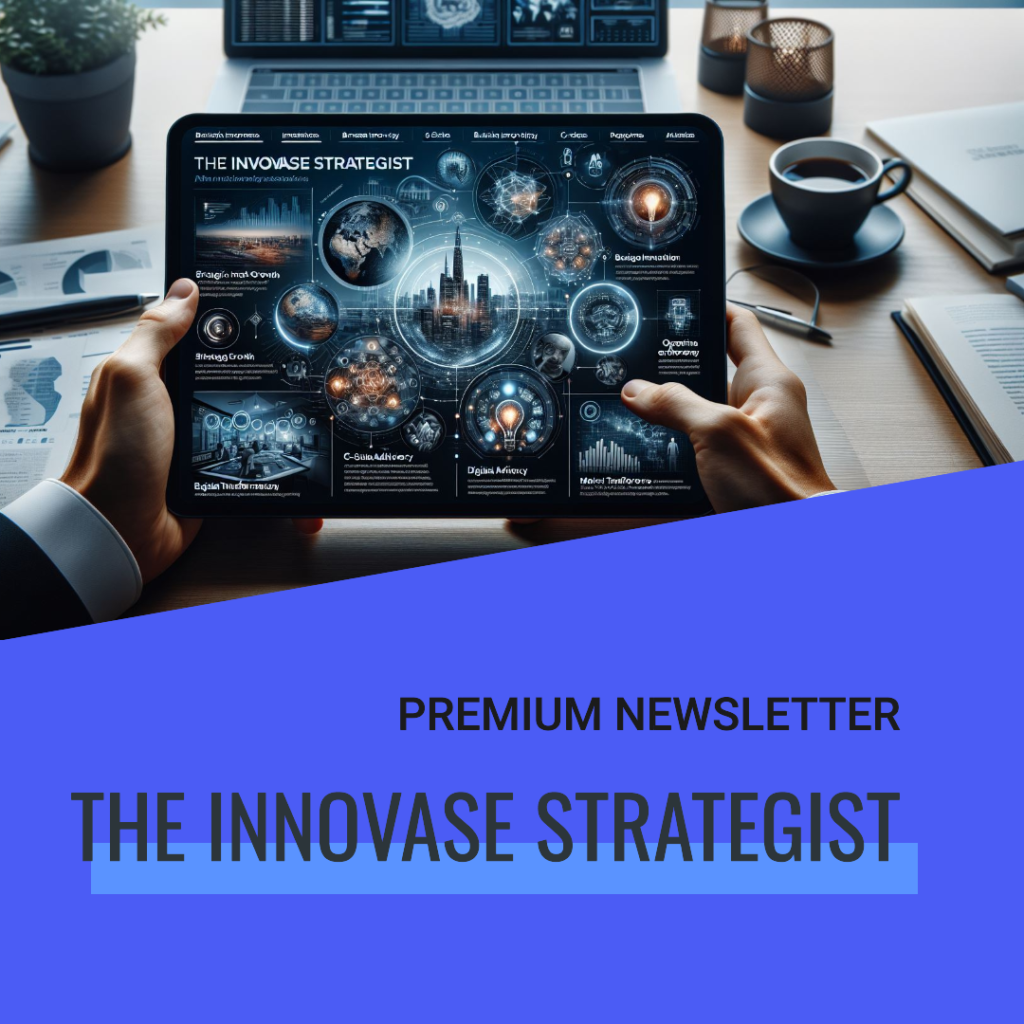How Innovative Strategies Are Changing the Business Landscape

In the rapidly evolving business landscape, innovative strategies stand out as a cornerstone for achieving competitive advantage and fostering continuous improvement 3. With 82% of companies adopting a similar approach towards innovation as a means for incremental growth, it becomes evident that groundbreaking ideas rarely emerge from routine processes 1. The significance of having a structured innovation strategy is underscored in the work “You Need an Innovation Strategy” by Gary P. Pisano, which highlights how a well-articulated innovation strategy is crucial for not only innovating but also for sustaining performance over the long term 2.
As the business world grapples with high failure rates in innovation endeavors, examples from successful entities like Corning and Bristol-Myers Squibb show that the challenges often stem from a misalignment between the innovation efforts and the overarching business strategy 2. This article delves into the essence of an innovation strategy, discussing its development stages, types, and implementation methods. Moreover, it will illuminate how a clearly defined innovation framework, bolstered by innovation management, leadership, culture, and the integration of diverse perspectives, can serve as the linchpin for an effective innovation system 23.
The Essence of an Innovation Strategy
At the core of every successful business lies an effective innovation strategy, which serves as a blueprint for navigating the complex terrain of market competition and customer needs. Understanding the essence of an innovation strategy involves dissecting its key components and objectives:
Guiding Resource Allocation:
- An innovation strategy outlines how resources are earmarked for fostering innovation within the organization. It is a deliberate plan that specifies the allocation of time, talent, and finances towards innovative endeavors to achieve long-term organizational goals 4.
- This strategic focus ensures that different types of innovation, whether technological advancements or business model transformations, are adequately funded and supported 4.
Answering Critical Questions:
- Value Creation: How will innovation create value for customers? This involves identifying opportunities for innovation that meet unfulfilled customer needs or enhance the customer experience 2.
- Value Capture: Determining how the company will capture a share of the value its innovations generate. This could be through competitive pricing strategies, intellectual property rights, or first-mover advantages 2.
- Innovation Types: Deciding which types of innovation to pursue. Should the focus be on disruptive technologies, incremental improvements, or a combination of both? This decision will guide the innovation process and resource allocation 2.
Strategic Alignment and Evolution:
- An innovation strategy must be closely aligned with the company’s overall business strategy and core capabilities. This alignment ensures that the innovation efforts complement and enhance the business’s value proposition 2.
- Recognizing that innovation strategies must evolve. As the market landscape changes and new technologies emerge, the innovation strategy should be flexible enough to adapt. This requires ongoing evaluation and adjustment by the leadership to stay ahead of the curve 2.
The essence of an innovation strategy lies in its ability to systematically guide a company through the complexities of innovation. By setting clear objectives, allocating resources judiciously, and ensuring alignment with the broader business goals, an innovation strategy can pave the way for sustained competitive advantage and long-term success 145.
“Innovation distinguishes between a leader and a follower. It’s not about having new ideas, but about executing them well and bringing them to life in a way that disrupts the market and adds value.” – Inspired by Steve Jobs

Stages in Developing an Innovation Strategy
- Objective Setting and Strategic Alignment:
- Determine the Innovation Strategy Objective: Begin by examining the overall business objectives to identify how innovation can contribute to sustainable competitive advantage 4.
- Align Innovation with Business Strategy: Ensure that the innovation strategy is in harmony with the company’s broader business goals, creating a unified direction for growth 6.
- Team Engagement and Resource Allocation:
- Executive Team Onboarding: Secure commitment from the executive team to foster a shared vision of success, with innovation at its core 4.
- Allocate Resources: Conduct a comprehensive audit of the current innovation landscape within the organization to understand where resources are needed most. This includes time, talent, and finances 4.
- Market Understanding and Value Proposition:
- Gather Customer Insight: Utilize customer feedback and market analysis to inform the direction of innovation efforts, ensuring they meet unmet needs or enhance customer experiences 4.
- Define Your Value Proposition: Clearly articulate how your innovation will create value for customers, distinguishing your offerings from competitors 5.
- Innovation System Development:
- Develop an Innovation System: Focus on five key areas of management to foster an environment conducive to innovation. This includes tools, processes, and techniques for taking an idea from concept to fruition 4.
- Establish Innovation Techniques and Systems: Implement systems and techniques that support the innovation process, from idea generation to diffusion 5.
- Strategic Choices and Continuous Assessment:
- Strategy Choice Cascade: Utilize the Strategy Choice Cascade framework to make strategic choices that define your winning aspiration, value proposition, enabling systems, key metrics, and competitive advantage 5.
- Assess and Adjust: Continuously review the innovation strategy to ensure it remains aligned with business objectives and market needs. This involves learning the unmet needs of your customers and adjusting the strategy as necessary 6.
By following these stages, organizations can develop a robust innovation strategy that not only aligns with their business goals but also positions them for sustained growth and competitiveness in their respective markets.
"Unlock Your Strategic Potential Now"
Types of Innovation Strategies
In the dynamic realm of business, understanding the spectrum of innovation strategies is pivotal for steering organizations towards sustained growth and market leadership. These strategies, characterized by their approach towards development, market adaptation, and technological advancement, can be broadly categorized into several types:
Incremental vs. Radical Innovation
- Incremental Innovation: Focuses on making gradual improvements to existing products, services, or processes, enhancing efficiency and customer satisfaction with a low-risk profile 124.
- Example: Continuous updates in software functionalities or refining manufacturing processes.
- Radical Innovation: Involves revolutionary technology and business models, addressing needs that were previously unidentified, thus dramatically changing the industry structure with a high-risk, high-return profile 4.
- Example: The introduction of the first smartphone radically changed the telecommunications and computing industries.
Disruptive vs. Sustaining Innovation
- Disruptive Innovation: Rewrites industry rules by offering better services and more options, often by creating new value chains or market spaces 1112.
- Example: Netflix’s transformation of the entertainment industry, Uber’s reshaping of transportation services.
- Sustaining Innovation: Aims at improving and expanding existing value networks to better meet customer needs without altering the market dynamics significantly 13.
- Example: Incremental upgrades in automobile safety features or enhancing the energy efficiency of home appliances.
Open vs. Closed Innovation
- Open Innovation: Embraces external ideas and paths to market, leveraging collaborations to co-create products and solutions 8.
- Example: Procter & Gamble’s partnership with external innovators leading to the creation of the Swiffer duster and Olay Regenerist line.
- Closed Innovation: Relies on internal R&D efforts to generate new products and technologies, keeping the innovation process within the company’s control 9.
- Characteristic: Autonomous innovation strategy focusing on in-house development.
Proactive vs. Reactive Strategies
- Proactive Innovation Strategies: Characterized by a strong research orientation, aiming for first-mover advantage and being a technology market leader with a broad knowledge base and high risk exposure 10.
- Example: Apple’s introduction of the iPhone, Singapore Airlines’ continual service innovation.
- Reactive Innovation Strategies: These strategies involve a wait-and-see approach, focusing on operations and seizing low-risk opportunities as followers in the market 10.
- Example: Companies that adjust product lines in response to established market trends without leading the change.
By strategically choosing and implementing these innovation strategies, businesses can navigate the complexities of the market, leveraging innovation as a key driver for achieving competitive advantage, fostering an innovation culture, and ensuring continuous improvement in their operations 3810111213.
Implementing Your Innovation Strategy
Implementing an effective innovation strategy requires a multifaceted approach, blending insights from leading tech giants with practical, ground-up initiatives. Here’s a guide to navigating this process:
Autonomous Innovation and AI Integration
- Leverage Leading Tech Insights: Draw inspiration from the activities of tech giants such as Apple, Amazon, and Google. These companies offer a plethora of webinars, insights, tools, and examples that can serve as a blueprint for your innovation strategy 9.
- Embrace AI-powered Innovation Sprints: Dedicate focused time to innovation through AI-powered sprints. This approach accelerates the ideation and development process, pushing your team to deliver innovative solutions within a constrained timeframe 9.
- Establish a Creative AI Hub: Create a centralized resource or platform dedicated to exploring and leveraging AI in creative processes. This hub can foster a culture of innovation and provide the tools necessary for your team to experiment with AI-driven solutions 9.
Engaging Employees and Harnessing Opportunities
- Spot and Prioritize Opportunities: Identify innovation opportunities by solving problems and creating value in new ways. Prioritize these based on potential value, ensuring efforts are focused where they can make the most impact 14.
- Prototype and Test Innovations: Start with simple and inexpensive “paper prototypes” to test your ideas. This low-fidelity approach allows for quick iteration and refinement based on feedback 14.
- Build Support with a Compelling Story: Communicate your innovation story effectively to all stakeholders. A well-articulated narrative can build support and enthusiasm for your innovation efforts, facilitating smoother implementation 14.
Learning and Continuous Improvement
- Adopt a ‘Fail Fast, Learn Fast’ Mantra: Encourage a culture that views failure as a learning opportunity. Quick cycles of trial and error can lead to faster innovation and improvement over time 14.
- Leverage Employee-driven Innovation: Recognize that some of the most impactful innovations come from those closest to the customer – your employees. Engaging them in the innovation process can uncover unique insights and drive more meaningful outcomes 14.
- Benefits of Business Innovation: Understand that effective innovation can lead to competitive advantages, meet customer demands, drive business growth, increase efficiency, and attract and retain talent. Keeping these benefits in mind can help align and motivate the organization towards its innovation goals 15.
By integrating these strategies, businesses can create a dynamic and responsive innovation ecosystem that leverages the best of technology, employee insight, and strategic focus to stay competitive and relevant in today’s fast-paced market.
“The only way to win at a disruptive game is to innovate so radically that you create your own game. True innovation requires seeing beyond the horizon and crafting a vision that reshapes the market.” – Inspired by Reed Hastings

Case Studies of Successful Innovation Strategies
Exploring the landscape of business innovation, several companies stand as beacons of success, demonstrating the power of strategic innovation in transforming industries and consumer behaviors. Here, we delve into a few exemplars:
A titan in research and development, Amazon sustains a startup culture despite its massive scale, leading to the creation of pioneering services like Amazon Prime, Alexa, and the cashier-less stores of Amazon Go. This relentless pursuit of innovation underlines the importance of maintaining agility and a forward-thinking mindset in business strategy 16.
Known for its disruptive approach, Tesla has not only introduced electric vehicles to the mainstream market but also advanced autonomous driving technologies. Tesla's journey underscores the significance of visionary leadership and the ability to win support for groundbreaking ideas, proving that with the right strategy, even the most ambitious technological advancements can achieve widespread adoption 16.
- Google champions employee-driven innovation, allowing its workforce to dedicate 20% of their time to personal projects. This policy has birthed revolutionary products like Gmail and Google Maps, illustrating the value of empowering employees to explore new ideas 16.
- Apple, on the other hand, adopts a more calculated approach, observing technology trends and then introducing innovative products like the iPhone. This strategy highlights the benefit of timing and the ability to refine and perfect an idea before bringing it to market 16.
Both companies have redefined their respective industries by leveraging technology to offer novel services—Uber transforming personal transportation and Airbnb disrupting the traditional lodging market. Their success stories emphasize the power of innovation in creating new market spaces and reimagining established industries 11.
Netflix revolutionized media consumption with its subscription-based, on-demand streaming service, moving away from traditional TV models. Similarly, Stripe simplified online transactions, enabling seamless integration of payment processing for businesses. These cases highlight how innovative business models can address unmet market needs and set new industry standards 11.
Each of these case studies not only showcases the diverse approaches to innovation strategy but also reinforces several key principles for success, including the importance of understanding your audience, prioritizing data privacy and security, fostering collaboration and partnerships, and committing to continuous improvement and measurement 17. Through these examples, it’s evident that a well-executed innovation strategy can significantly impact an organization’s ability to compete and thrive in today’s dynamic business environment.
FAQs
- Why is Having an Innovation Strategy Crucial for Businesses?
- How Does Innovation Impact the Business Environment?
- What Constitutes an Innovation Strategy, and Why Might Companies Alter Theirs?
- What Does an Innovative Approach to Business Strategy Entail?
An innovation strategy is essential because it outlines how a business will utilize its resources to achieve innovation goals, deliver value, and gain a competitive edge. This strategy involves analyzing the business’s competitive and technological landscape, as well as its external challenges and opportunities, to guide decision-making.
Innovation plays a critical role in ensuring a company’s success in the competitive business landscape of today. As customers become more demanding and knowledgeable, businesses need to innovate to enhance their productivity, growth, and profitability. Innovation provides the necessary edge for entrepreneurs to survive and excel.
An innovation strategy is a detailed plan outlining how a business intends to generate and implement new ideas. It encompasses the tools, processes, and techniques for evolving an idea from its inception to realization, including methods to predict the idea’s success. Companies might change their innovation strategy to adapt to new insights, technologies, or market demands, ensuring they remain competitive and relevant.
Adopting an innovative approach to business strategy involves a departure from relying on past models, forms, or styles. It requires a readiness to discard preconceived notions and view reality from a fresh perspective. This mindset is crucial for devising original and effective strategies.
References
"Unlock Your Strategic Potential Now"
[1] – https://www.coursehero.com/file/p51mpg9/Conclusion-In-conclusion-strategic-planning-is-very-important-for-any/ [2] – https://americandrycleaner.com/node/91906 [3] – https://online.hbs.edu/blog/post/why-is-strategic-planning-important [4] – https://www.clearpointstrategy.com/blog/the-benefits-of-strategic-planning [5] – https://www.investopedia.com/financial-edge/0612/the-importance-of-strategic-planning.aspx [6] – https://www.thealternativeboard.com/blog/why-is-strategic-planning-important [7] – https://www.linkedin.com/pulse/importance-strategic-planning-business-success-gavin-bottrell [8] – https://envisio.com/blog/benefits-of-strategic-planning/ [9] – https://hbr.org/1994/01/the-fall-and-rise-of-strategic-planning [10] – https://opentextbc.ca/strategicmanagement/chapter/conclusion/ [11] – https://www.quora.com/What-are-some-good-strategic-management-case-studies-of-businesses-firms-where-they-failed-to-due-inefficient-strategies [12] – https://hbr.org/2023/09/a-new-approach-to-strategic-innovation [13] – https://www.planview.com/resources/guide/strategic-planning-deliver-value/strategic-innovation-and-why-its-important/ [14] – https://www.techtarget.com/searchcio/definition/strategic-planning [15] – https://asana.com/resources/strategic-planning [16] – https://corporatefinanceinstitute.com/resources/management/strategic-planning/ [17] – https://www.thealternativeboard.com/strategic-business-plan [18] – https://lucidspark.com/blog/key-components-of-a-strategic-plan [19] – https://www.linkedin.com/pulse/importance-strategic-planning-execution-harikishan-mahaur [20] – https://www.linkedin.com/advice/1/what-most-innovative-approaches-strategic-planning [21] – https://stormboard.com/blog/why-an-innovation-strategy-is-essential [22] – https://medium.com/@theactivepen/the-role-of-innovation-in-strategic-planning-91923898cd13 [23] – https://spur-reply.com/blog/the-6-elements-of-effective-strategic-planning [24] – https://skylineg.com/resources/blog/what-is-strategic-planning [25] – https://www.cascade.app/blog/5-key-elements-strategic-plan [26] – https://www.linkedin.com/pulse/key-elements-successful-corporate-strategic-plan-rizwan-khan-fcca [27] – https://medium.com/@KeithKrach/5-key-components-of-a-powerful-strategic-plan-4fbb6f15eae3 [28] – https://www.linkedin.com/pulse/5-essential-elements-strategic-planning-collin-earnst [29] – https://www.viima.com/blog/innovation-strategy [30] – https://www.quora.com/Why-is-there-a-need-for-strategic-planning [31] – https://www.linkedin.com/pulse/9-benefits-strategic-planning-divya-chopra [32] – https://www.linkedin.com/pulse/9-benefits-strategic-planning-businesses-matthew-sayles [33] – https://thinkgagnonassociates.com/case-studies/orvis-company [34] – https://lucidspark.com/blog/the-pitfalls-of-strategic-planning [35] – https://www.forbes.com/sites/forbestechcouncil/2022/08/02/the-four-biggest-obstacles-to-strategic-planning/ [36] – https://aalgroup.org/strategic-planning-5-common-challenges/ [37] – https://www.cssp.com/how-to-avoid-the-challenges-of-strategic-planning/ [38] – https://www.municipalworld.com/feature-story/5-strategic-planning-challenges/ [39] – https://nap.nationalacademies.org/read/13819/chapter/6 [40] – https://testlify.com/case-studies-of-strategic-human-resource-planning/
Subscribe Now Discover Exclusive Insights with the Innovase Strategist Newsletter
The Innovase Strategist premium newsletter offers a wealth of exclusive insights and expert analysis to fuel your strategic decision-making and drive innovative thinking. Stay ahead of industry trends, gain valuable insights, and receive actionable advice delivered straight to your inbox. Ignite your business potential and spark new ideas for impactful change within your organization.
Why Subscribe?
- Stay ahead of industry trends and gain valuable insights
- Receive expert analysis and actionable advice delivered straight to your inbox
- Ignite your strategic decision-making and foster innovative thinking
- For Only $349 per year
Don’t Miss Out! Click the Learn more now to gain an edge over the competition with Innovase Strategist.
Innovative Leadership: Driving Success in Healthcare
Innovative Leadership: Driving Success in Healthcare In today’s rapidly evolving healthcare landscape, the need for visionary leadership qualities capable of navigating compl
Revolutionizing Healthcare Staffing: Embracing Digital Transformation
Revolutionizing Healthcare Staffing: Embracing Digital Transformation In the rapidly evolving landscape of healthcare, technological advancements are reshaping every facet, from pa
Becoming a Trusted Advisor: Strategic Insights for Effective Client Relationship Management
Becoming a Trusted Advisor: Strategic Insights for Effective Client Relationship Management Understanding the role of a trusted advisor In the dynamic landscape of business, the ro
How To Strategically Manage Cash Flow: Budgeting & Forecasting Guide
How to Strategically Manage Cash Flow: Budgeting & Forecasting Guide Introduction to cash flow management Effective cash flow management is a critical aspect of running a succ
Mastering Remote Work: 7 Strategies to Boost Productivity and Thrive in the Digital Age
Mastering Remote Work: 7 Strategies to Boost Productivity and Thrive in the Digital Age The rise of remote work The advent of the digital era has ushered in a paradigm shift in the
Unleashing the Power of Strategic Growth: The 3 Game-Changing Ways to Propel Your Business Forward
Unleashing the Power of Strategic Growth: The 3 Game-Changing Ways to Propel Your Business Forward Understanding Strategic Growth Strategic growth is not just a buzzword; it’
Why Market Intelligence Is Important: A Deeper Look into Modern Analytics
Why market intelligence is Important: A Deeper Look into Modern Analytics In today’s competitive business landscape, understanding the external environment is no longer optio
How Innovative Strategies Are Changing the Business Landscape
How Innovative Strategies Are Changing the Business Landscape In the rapidly evolving business landscape, innovative strategies stand out as a cornerstone for achieving competitive
Why Strategic Planning is Important: A Deeper Look into Future Business Growth
Why Strategic Planning is Important: A Deeper Look into Future Business Growth Strategic planning is fundamental for any business aiming for longevity and growth, serving as a com
Innovative Leadership: Driving Success in Healthcare
Innovative Leadership: Driving Success in Healthcare In today’s rapidly evolving healthcare landscape, the need for visionary leadership qualities capable of navigating compl
Revolutionizing Healthcare Staffing: Embracing Digital Transformation
Revolutionizing Healthcare Staffing: Embracing Digital Transformation In the rapidly evolving landscape of healthcare, technological advancements are reshaping every facet, from pa
Becoming a Trusted Advisor: Strategic Insights for Effective Client Relationship Management
Becoming a Trusted Advisor: Strategic Insights for Effective Client Relationship Management Understanding the role of a trusted advisor In the dynamic landscape of business, the ro
How To Strategically Manage Cash Flow: Budgeting & Forecasting Guide
How to Strategically Manage Cash Flow: Budgeting & Forecasting Guide Introduction to cash flow management Effective cash flow management is a critical aspect of running a succ
Mastering Remote Work: 7 Strategies to Boost Productivity and Thrive in the Digital Age
Mastering Remote Work: 7 Strategies to Boost Productivity and Thrive in the Digital Age The rise of remote work The advent of the digital era has ushered in a paradigm shift in the
Unleashing the Power of Strategic Growth: The 3 Game-Changing Ways to Propel Your Business Forward
Unleashing the Power of Strategic Growth: The 3 Game-Changing Ways to Propel Your Business Forward Understanding Strategic Growth Strategic growth is not just a buzzword; it’
Why Market Intelligence Is Important: A Deeper Look into Modern Analytics
Why market intelligence is Important: A Deeper Look into Modern Analytics In today’s competitive business landscape, understanding the external environment is no longer optio
How Innovative Strategies Are Changing the Business Landscape
How Innovative Strategies Are Changing the Business Landscape In the rapidly evolving business landscape, innovative strategies stand out as a cornerstone for achieving competitive
Why Strategic Planning is Important: A Deeper Look into Future Business Growth
Why Strategic Planning is Important: A Deeper Look into Future Business Growth Strategic planning is fundamental for any business aiming for longevity and growth, serving as a com
Innovative Leadership: Driving Success in Healthcare
Innovative Leadership: Driving Success in Healthcare In today’s rapidly evolving healthcare landscape, the need for visionary leadership qualities capable of navigating compl
Revolutionizing Healthcare Staffing: Embracing Digital Transformation
Revolutionizing Healthcare Staffing: Embracing Digital Transformation In the rapidly evolving landscape of healthcare, technological advancements are reshaping every facet, from pa
Becoming a Trusted Advisor: Strategic Insights for Effective Client Relationship Management
Becoming a Trusted Advisor: Strategic Insights for Effective Client Relationship Management Understanding the role of a trusted advisor In the dynamic landscape of business, the ro
How To Strategically Manage Cash Flow: Budgeting & Forecasting Guide
How to Strategically Manage Cash Flow: Budgeting & Forecasting Guide Introduction to cash flow management Effective cash flow management is a critical aspect of running a succ
Mastering Remote Work: 7 Strategies to Boost Productivity and Thrive in the Digital Age
Mastering Remote Work: 7 Strategies to Boost Productivity and Thrive in the Digital Age The rise of remote work The advent of the digital era has ushered in a paradigm shift in the
Unleashing the Power of Strategic Growth: The 3 Game-Changing Ways to Propel Your Business Forward
Unleashing the Power of Strategic Growth: The 3 Game-Changing Ways to Propel Your Business Forward Understanding Strategic Growth Strategic growth is not just a buzzword; it’
Why Market Intelligence Is Important: A Deeper Look into Modern Analytics
Why market intelligence is Important: A Deeper Look into Modern Analytics In today’s competitive business landscape, understanding the external environment is no longer optio
How Innovative Strategies Are Changing the Business Landscape
How Innovative Strategies Are Changing the Business Landscape In the rapidly evolving business landscape, innovative strategies stand out as a cornerstone for achieving competitive
Why Strategic Planning is Important: A Deeper Look into Future Business Growth
Why Strategic Planning is Important: A Deeper Look into Future Business Growth Strategic planning is fundamental for any business aiming for longevity and growth, serving as a com










